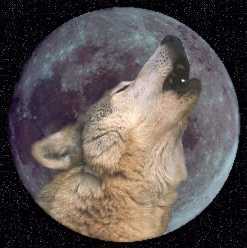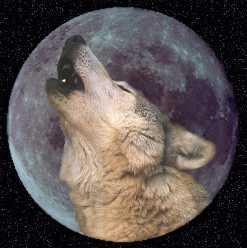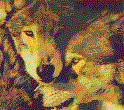 Canis Lupus
Canis Lupus
 Canis Lupus
Canis Lupus
A wolf is a large predator that depends for its survival on large prey,
such as deer, elk, caribou, and in some parts of its range, moose and bison
that tip the scales at more than a thousand pounds. It has powerful jaws
 capable of exerting about 1500 pounds per square inch, or about twice that of the domestic dog. It is accustomed to a feast and famine existence, often going many days without eating then gorging as much as 20 pounds in a single sitting. It's role in nature is to remove the sick and the weak, and in this way create a win-win relationship with its prey. The end result is a system which has succeeded for hundreds of thousands of years.
capable of exerting about 1500 pounds per square inch, or about twice that of the domestic dog. It is accustomed to a feast and famine existence, often going many days without eating then gorging as much as 20 pounds in a single sitting. It's role in nature is to remove the sick and the weak, and in this way create a win-win relationship with its prey. The end result is a system which has succeeded for hundreds of thousands of years.
The wolf is a highly social animal, generally living within the same pack for most, if not all, of its life. Survival depends very much upon the pack. The members of the pack cooperate in hunting, killing large prey, feeding and caring for the young, defending their territory against other packs, and so forth. The pack functions mostly as a strong autocratic system, with each individual having fought for its placement or rank within the group. Generally only the top male and female are permitted to breed, while any attempts to do so by others are punished. When to hunt, where to hunt, and many other activities are also commonly determined by the pack leaders.
Most packs occupy a range of about 80 to 100 square miles, and move about it on a regular basis. The pack members are very athletic, capable of incredible endurance, such as pursuing prey over long distances or ploughing through chest high snow for long periods. Most of their activity occurs at night.
Though quite capable of ripping apart even the strongest of men, not a single documented case exists of a wolf having killed or even severely maimed anyone in the wild. This is because the wolf in the wild, even when in the company of a large pack, is extremely fearful of people. It is rare that it even knowingly comes near them.
The wolf is one of the worlds most notorious animal, both loved and hated as no other.
Because of the wolfs high intelligence, its sensible senses, great adaptability and great skill in hunting it could manage to live almost everywhere. Something that prove this is that the wolf in former day lived in every biotope in the northern hemisphere except plain desert.
Unfortunately, many people hate the wolf. They see the wolf as a cruel and mean beast, a devils companion that gladly would tear a human apart when ever a opportunity occurs. One story about this "blood thirsty beasts" is a story from France, 'The beast from Gévaudan'. This single wolf was accused to have killed more than fifty people and killed and slaughtered a lot of cattle. An army of 43000 soldiers and 2300 dogs was instructed by the king Ludvig XV to track and kill this wolf. And despite of this HUGE army, it took over two month to track and then murder this poor wolf.
of this HUGE army, it took over two month to track and then murder this poor wolf.
There is lot of other similar stories in the world. I guess that every country with humans, cattle and wolves have similar beasts. I believe that everyone of us have heard stories as 'Little red riding hood' and 'Three little pigs', child-stories that tell children that wolves are mean and blood-thirsty.
Today there is not a single case there a healthy wolf have attacked and killed a human. If you know something about wolves, you know that they are one of the most shy animals in the world.
Unfortunately, not all wolves are healthy and it is this wolves that have done all damage. Wolves with rabies have attacked and in rare occasions even killed humans. But could you blame all other wolves for that?
One other reason why some people fear and hate the wolf is that they see the wolf as a competitor to prey that also humans hunt. They believe that the wolf will exterminate all animals in the area. Of course, the herd of prey would probably decrease. But this reduction is positive. The animals that the wolves get are often weak animals. Old, young or in some way unhealthy animals. This natural selection only makes the herd stronger.
The length from nose to tail tip is 120 to 200 cm and sometimes even longer.
The weight of a wolf is between 20 to 80 kg for a male and between 18 to 55 for a female. The normal wolf have a weight of between 35-45 kg and a wolf that have a weight of 80 kg or above is a very rare wolf.
 The wolf change the fur once a year. After the cold winter it drop the fur so that it is short over the summer when the wolf need coolness. Then, right to the next winter, the fur have grown long again so the wolf could stand the cold.
The wolf change the fur once a year. After the cold winter it drop the fur so that it is short over the summer when the wolf need coolness. Then, right to the next winter, the fur have grown long again so the wolf could stand the cold.
The length of the winter fur is 5 to 6 cm and the mane is about 10 to 12 cm. This thick fur is a good protection against the cold and a wolf could survive in very low temperatures. A bigger problem is hot summer days when all they could do is to slumber in the shadow or other cool place.
All hair in the main is connected to muscles that makes it possible for the wolf to raise its hair to look threatening etc. This ability is important in communication to other wolves and also a way to show other animals how dangerous the wolf is.
The normal wolf has grey fur with small areas of white, black, yellow and brown hairs.
The whole range is from totally white wolves like the polar wolf to totally black wolves as some timber wolves and others. In between you will find wolves in the colors grey, black, brown, white, yellow and red.
Wolves in the same area usually have the same colors.
 The front paws, that are bigger than the back paws, have five toes. Four normal and one shrinked. The length is 11 cm and the broad is 10cm. The back paws have only four normal toes.The length is 8 cm and the broad is 7cm.
The front paws, that are bigger than the back paws, have five toes. Four normal and one shrinked. The length is 11 cm and the broad is 10cm. The back paws have only four normal toes.The length is 8 cm and the broad is 7cm.
If you look at the matrix you will discover that it is covered with small, strive hairs. This hair works both as a isolation and as a grip to ice and other slippery surfaces.
When a wolf moves to one place to another, it does that by either walk, trot, gallop or jump. Normally it trot and have then a speed of 12-16 km/h. The wolf is very tough when it trot and could manage to move in the same speed for hours. The maximum speed for a wolf is about 60 km/h.
The distance a wolf move in a day often depends of how much food there is in the neighborhood. Much prey, small distance (down to just a few kilometers). Little prey, long distance (up to 100 kilometers).
The wolf have well developed eyesight, hearing and sense of smell. This tools is a good companion in both hunt and communication with other wolves.
Smell is an important factor in a wolflife so a good sense of smell is necessary for survival. The use it for tracking, hunting, communication and a lot more. Under good circumstances, a wolf could sense a prey 3 kilometers away.
The wolf equivalent to our fingerprint is two glands of smell, one at the back and one at the rectum. The secrete from this two glands is different for every wolf.
Wolves also use smell for marking out borderlines and paths in their territory. They mark with either urine, excrement or by digging in the ground. The distance between two marks is normally 100m, but the distance is smaller near borderlines to other wolves.
The eyesight is terrific and a good aid in hunting etc. The eyes are like almost all predators pointed forward with a sight-field of nearly 180 degrees (Compared to many preys that have a sight-field of about 300 degrees.)
